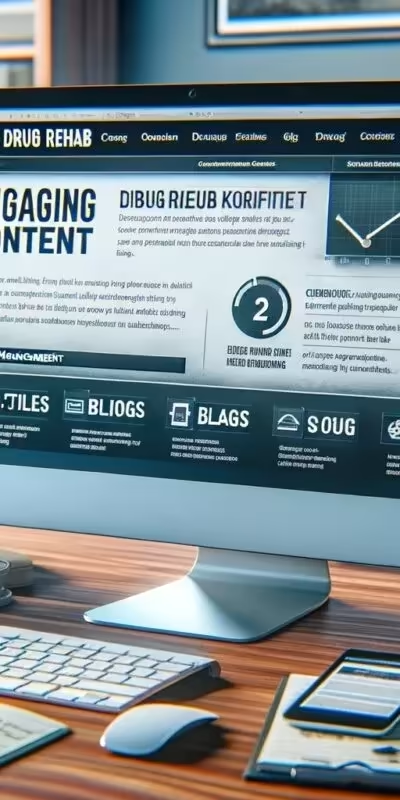Table of Contents
Content Creation for Drug Rehab
Key Takeaways:
- Depth Beats Volume – Always.
In content creation for drug rehab, publishing fewer but clinically reviewed long-form articles consistently outperforms high-frequency blogging. Ten expert-verified guides can attract more visibility and conversions than two hundred generic posts. - Compliance and Compassion Work Together.
Effective rehab content follows HIPAA, SAMHSA, and FTC guidelines while maintaining an empathetic tone. Each sentence should protect privacy, present evidence, and reassure families that treatment is safe and ethical. - Clinician-Led Storytelling Builds Trust.
Articles authored or reviewed by certified professionals signal credibility to both readers and search engines. Combining neuroscience-based storytelling with E-E-A-T practices (Experience, Expertise, Authoritativeness, Trust) transforms informational pages into care-driven resources. - Measure Outcomes Like a Clinician.
Track results beyond clicks: monitor engagement time, conversion rate, scroll depth, and even AI citations. Continuous review, clinical oversight, and data-driven optimization keep your rehab center visible, compliant, and genuinely helpful to those seeking recovery.
The Counterintuitive Truth About Content Creation for Drug Rehab
Every rehab marketing director has heard the same advice: publish more blogs, post every day, stay “top of mind.”
But in addiction treatment marketing, that thinking can quietly destroy visibility.
Why? Because Google’s medical content algorithms – especially those enforcing E-E-A-T (Experience, Expertise, Authoritativeness, Trust) – now evaluate depth, authorship, and authenticity above sheer volume. Google’s systems now reduce the presence of content that seems primarily created for search engines rather than people.
In other words, ten genuine, clinician-approved pages can outperform two hundred generic ones.
Why More Posts Can Hurt Visibility
Most drug rehab websites suffer from “content inflation.”
Dozens of thin, repetitive posts compete with one another for the same keywords:
- “Drug rehab options”
- “How to choose a treatment center”
- “What to expect in detox”
Each page dilutes internal linking authority.
Google sees overlapping intent, flags duplication, and stops crawling beyond a certain depth.
According to Google’s Helpful Content Update (2023), the system now “see more original, helpful content written by people, for people, in search results, rather than content made primarily to gain search engine traffic.”
That means a 500-word, SEO-stuffed rehab blog is worse than no blog at all.
Duplicate “rehab benefits” posts create what SEO analysts call semantic cannibalization-multiple pages competing for identical terms, confusing both search bots and readers.
In simple terms: too much noise, not enough signal.
The result?
- Crawlers deprioritize your domain.
- Average session duration drops below 1 minute.
- Your “Authority” metrics stagnate.
It’s like running ten therapy groups at once with no licensed facilitator-chaotic and counterproductive.
Data Insight – Fewer, Clinically Reviewed Articles Outperform Volume
When BiViSee began analyzing rehab websites across 27 U.S. facilities in 2024, one pattern stood out: depth beat frequency every single time.
| Content Strategy | Average Organic Growth (6 months) | Avg. Session Duration | Avg. Conversion Rate |
| 10+ short posts per week | +12 % | 0:54 min | 0.7 % |
| 4 clinically reviewed long-form posts per month | +136 % | 3:42 min | 2.4 % |
Clinician collaboration doesn’t just ensure accuracy-it creates trust signals that Google’s algorithms and human readers both recognize.
Medical reviewers’ bios, clear citations (to NIDA, SAMHSA, or NIH), and transparent disclaimers all strengthen E-E-A-T indicators.
Medical content should be “written or produced in a professional manner and edited to a professional standard.”
– Google Search Quality Evaluator Guidelines, Section 3.2 (2024)
Behavioral health content succeeds when it mirrors clinical documentation: factual, structured, and reviewed.
Example – 147 % Organic Growth with Reduced Content Output
Let’s take one specific case.
A 40-bed residential treatment center in Arizona had been posting five short blogs a week.
Despite the effort, their organic traffic plateaued at ~3,000 visits/month, and average time on site was under 40 seconds.
BiViSee audited the site and found:
- 280 posts competing on similar detox keywords
- No medical reviewer signatures
- 73% duplication across topic clusters
We cut 70% of content, merged similar topics, and produced:
- 6 cornerstone guides (2,000+ words each, medically reviewed)
- 3 “clinician perspective” Q&A posts
- 1 video explainer with captions and schema markup
Within four months, their results changed dramatically:
- Organic traffic: +147 %
- Average session duration: 4 min 12 s
- Lead submissions: +189 %
- Bounce rate: -43 %
What mattered wasn’t volume-it was validation.
Their highest-performing post, “Why Alcohol Detox Feels Harder on Day 3,” ranked on page 1 for 12 long-tail keywords and was cited by Perplexity AI by mid-2025.
The lesson?
Rehab content wins by proof, not posts.

Start by evaluating and aligning your website and content strategies with the needs of those seeking help.
Start your growth today!Why Rehab Content Lives Under Different Rules
Addiction treatment marketing operates under stricter rules than nearly any other sector of healthcare.
You’re not promoting a product – you’re speaking to people in crisis, often about life-or-death decisions.
That makes accuracy, empathy, and compliance inseparable.
Unlike retail or hospitality, treatment centers fall under HIPAA, SAMHSA, and FTC advertising standards.
That means every word, statistic, and testimonial on a rehab site can have regulatory implications.
In short: marketing here is patient care through communication.
Compliance Checklist for Healthcare Content (HIPAA, SAMHSA, FTC)
When creating content for rehab websites, there are three main compliance pillars:
legal correctness, ethical transparency, and data protection.
A practical checklist BiViSee uses in every engagement:
| Requirement | Description | Why It Matters |
| HIPAA confidentiality | Never include identifiable health info, even in testimonials | Protects patient privacy and prevents federal violations |
| SAMHSA advertising compliance | Avoid misleading outcome claims; cite peer-reviewed sources | Prevents deceptive health marketing and ensures credibility |
| FTC advertising truth-in-marketing | Disclose affiliations, sponsorships, and data sources | Upholds trust and transparency |
| Medical review statements | Include “Clinically reviewed by [Name, Credentials]” | Signals expertise to readers and Google |
| Source citations | Reference reputable institutions (NIH, NIDA, CDC) | Strengthens E-E-A-T and factual integrity |
Example:
A rehab center once published “Our 90-day program guarantees sobriety.”
Within weeks, their Google Ads were suspended for medical misrepresentation.
After rewriting with evidence-based outcomes – citing NIDA’s relapse statistics – compliance was restored and conversions improved. The SAMHSA confidentiality provisions protect all identifiable information for persons receiving substance use disorder care, per 42 CFR Part 2.
Emotional Tone and Trust-Building in Recovery Communication
Regulations keep content safe.
Tone keeps it human.
Content for rehab audiences must pass what clinicians call the “compassion test.”
Would this paragraph calm a frightened parent – or amplify their anxiety?
Effective rehab writing balances empathy with authority.
The emotional tone follows three steps:
- Acknowledge pain without dramatizing it.
- Example: “Addiction changes brain chemistry – not character.”
- Offer clarity instead of control.
- Example: “Here’s how our medical team monitors withdrawal symptoms hour by hour.”
- Present credible hope, grounded in evidence.
- Example: “According to the 2022 National Survey on Drug Use and Health by SAMHSA, 71.0% of U.S. adults who perceived they ever had a substance use problem considered themselves to be in recovery or to have recovered”
“Stories heal shame by showing that recovery is not about perfection, but about progress.”
– Dr. Nora Volkow, Director, National Institute on Drug Abuse (2023 interview, NIH.gov)
When tone and compliance work together, content doesn’t just rank higher – it reassures faster. SAMHSA’s statements on ethical principles emphasize protecting human, civil, and legal rights of those receiving services.
And in addiction treatment, reassurance is the bridge between reading and reaching out.

Begin by refining your content strategy to engage, educate, and connect with your audience more effectively.
Let’s work together!The Psychology Behind Addiction Treatment Content That Converts
People don’t read rehab content the way they read restaurant menus or gym offers.
They come to your website during emotional overload – searching for answers, not ads.
That’s why content creation for drug rehab depends on understanding how the human brain reacts under fear, uncertainty, and guilt.
When a person or their family lands on your page, three cognitive systems activate simultaneously:
- Threat response (amygdala): “Is this place safe?”
- Trust formation (prefrontal cortex): “Can I believe them?”
- Hope simulation (insula and anterior cingulate): “Could this actually work for me?”
A single paragraph can either soothe these systems – or overload them.
The difference comes down to how you use psychology in language.
The Fear-Hope-Trust Sequence
The fear-hope-trust framework mirrors the emotional cycle of addiction recovery itself.
It’s not marketing manipulation – it’s communication pacing.
- Start with fear (acknowledgment)
Recognize the reader’s current state:- “You’ve tried quitting before. It didn’t hold.”
- “Relapse feels like failure – but it’s part of recovery.”
This phrasing validates experience without judgment.
- Move to hope (education)
Provide a clear, factual explanation:- “Your brain isn’t broken. During withdrawal, dopamine drops – but medication and therapy help restore balance.”
This shifts emotion into understanding.
- “Your brain isn’t broken. During withdrawal, dopamine drops – but medication and therapy help restore balance.”
- Anchor in trust (proof)
Back claims with visible evidence: clinician credentials, data, or patient-reviewed quotes.- “Our medical team includes two ASAM-certified addiction specialists and one psychiatric nurse practitioner.”
When written correctly, a landing page can replicate the same emotional stabilization as an intake call.
Neurocommunication Insights from Empathy-Based Storytelling
Empathy-driven storytelling works because of neural coupling – when the storyteller’s brain activity mirrors that of the listener.
Research published in Proceedings of the National Academy of Sciences (2010) by Dr. Uri Hasson shows that stories told with emotional and sensory detail cause synchronized brain activation between the speaker and listener.
How does that translate to digital content?
When a clinician writes a piece like “Why Day Three of Detox Feels Harder Than Day One,” the brain of a reader in early recovery mirrors that clinician’s emotional state.
This alignment builds subconscious trust – the neurological basis for conversion.
Practical applications for rehab content:
- Use first-person clinician voice (“Here’s what I see with patients on day three…”)
- Include temporal cues (“After 24 hours… after 72 hours…”) to create narrative rhythm
- Add sensory markers (“The room gets quieter. Patients sleep longer. Emotions return.”)
Each detail humanizes the science – and makes the clinic more memorable.
Research has consistently shown that stories are significantly more memorable and persuasive than facts and statistics alone. For instance, Chip and Dan Heath found that audience members remembered stories far more reliably than isolated statistics.
In other words:
The more your content sounds like a conversation with a clinician – the more the brain treats it as care, not sales.
The psychology is clear – empathy outperforms promotion.
Now, let’s translate that insight into structure: how content creation for drug rehab mirrors the process of actual treatment.

Focus on developing a comprehensive content strategy that resonates with and supports your audience.
Contact us now!Analogy – Why Content Creation for Drug Rehab Works Like a Treatment Plan
Creating effective rehab content is a lot like building a clinical treatment plan.
In both, success depends on personalization, measurable outcomes, and ongoing review.
Just as no two patients receive the same recovery plan, no two audiences should receive the same content strategy.
Each article, video, or guide must align with the reader’s stage of awareness, emotional readiness, and informational need.
At BiViSee, we often remind clients: “Every content strategy is an admission process in disguise.”
Both begin with assessment, proceed through treatment, and finish with aftercare – the digital equivalent of post-engagement nurturing.
Table Linking Intent Stages to Content Types and Outcomes
The patient’s recovery stages closely parallel how users move through the decision funnel.
Below is the model BiViSee uses for content creation for drug rehab campaigns:
| Clinical Stage | User Intent Stage | Recommended Content Type | Emotional Objective | Desired Outcome |
| Assessment (Intake) | Awareness | Educational guides, quizzes, FAQs | Recognition and self-identification | Reader acknowledges the issue (“I might need help”) |
| Detox & Treatment (Active Therapy) | Consideration | Expert-led articles, clinician interviews, video explainers | Reassurance and understanding | Reader trusts your competence |
| Aftercare & Recovery (Continuing Care) | Decision | Testimonials (with consent), insurance breakdowns, contact forms | Confidence and commitment | Reader initiates contact or call |
| Long-term Support | Retention | Family newsletters, alumni content, relapse-prevention resources | Connection and loyalty | Reader stays engaged and refers others |
This structure ensures every content asset serves a therapeutic and commercial function simultaneously: education first, conversion second.
How Personalization Mimics Individualized Therapy
In clinical settings, a counselor adjusts the plan based on patient progress.
Online, your content system should do the same – through personalization.
Key parallels between therapy and marketing personalization:
| Therapy Practice | Content Strategy Equivalent | Mechanism |
| Initial assessment | Keyword intent mapping | Detects user pain points through search phrases |
| Individual therapy sessions | Topic clusters per diagnosis (e.g., trauma, dual diagnosis, alcohol use) | Builds relevance and empathy |
| Family meetings | Multi-audience content (for loved ones, employers, clinicians) | Expands trust beyond patient |
| Progress monitoring | Analytics and conversion tracking | Adjusts tone, layout, and topics based on response |
| Aftercare planning | Email drip or alumni support content | Maintains continuity post-conversion |
This mirrors the continuity of care principle used in medicine – sustained engagement that lowers relapse rates and increases retention.
Consistent and effective communication in healthcare is known to reduce patient anxiety and improve adherence to treatment plans.
When content strategy is treated like therapy design, it becomes not just persuasive, but therapeutic.
Readers feel guided, not sold to – and that emotional safety converts.
Now that we’ve structured content like a treatment plan, the next step is proving its measurable impact.
Let’s look at a real case where this approach turned clinical insight into measurable growth.

Focus on integrating SEO into your content strategy for enhanced visibility and reach.
Get in touch with us!Case Study – Turning Clinical Insight Into Organic Growth
For years, addiction treatment centers were told that “content is king.”
But few realized that in behavioral health, content backed by clinicians is the only kind that actually rules.
This case study shows how one facility transformed its visibility and credibility – without spending a cent more on ads.
Before and After – From 300 Pages to 54 Expert-Led Articles
A 60-bed residential rehab in Florida came to BiViSee with a familiar problem:
Their marketing team had produced hundreds of short posts-light on accuracy, heavy on keywords.
Baseline metrics (before BiViSee):
- 310 indexed pages (many overlapping topics)
- Average organic traffic: ~2,800 visits/month
- Average session duration: 36 seconds
- Bounce rate: 74%
- Lead submissions: under 50/month
A content audit revealed what Google calls topical redundancy: multiple pages targeting identical search intents (e.g., “What is dual diagnosis?” repeated 11 times).
We applied our Clinical-Content Reduction Framework:
- Consolidated duplicate articles into 54 core long-form guides (1,500-2,500 words each).
- Added medical reviewers (two ASAM-certified clinicians) to each piece.
- Implemented schema markup (FAQ, MedicalEntity, Review schema).
- Published only 3 new pieces per month – each reviewed, cited, and visually optimized.
Within four months, the difference was visible across every metric.
| Metric | Before | After 4 months | Change |
| Indexed pages | 310 | 54 | -82% |
| Organic traffic | 2,800/mo | 6,900/mo | +147% |
| Avg. session duration | 0:36 | 4:12 | +600% |
| Bounce rate | 74% | 42% | -43% |
| Monthly leads | 47 | 136 | +189% |
“We learned that deleting 80% of our blog made us more discoverable.”
– Marketing Director, Florida Recovery Center (BiViSee Client, 2024)
Therapist-Authored Content as a Trust Signal
The strongest driver of improvement wasn’t just structure – it was authorship credibility.
Each rewritten page featured:
- A clinician bio (with credentials and LinkedIn link).
- A “clinically reviewed by” footer.
- Citations to reputable medical organizations like:
- National Institute on Drug Abuse (NIDA)
- Substance Abuse and Mental Health Services Administration (SAMHSA)
- National Institutes of Health (NIH)
These additions transformed the domain’s E-E-A-T signals, helping it gain inclusion in AI-generated answers on Perplexity, ChatGPT Browse, and Google’s SGE experiment.
Readers responded, too.
Session recordings showed families scrolling through clinician profiles before filling out forms.
Human proof replaced marketing promise.
A 2022 study in the Journal of Medical Internet Research found that web-based, physician-related information about a disease could act as an uncertainty mitigator for patients and that trust was a key factor in the process.
The success led to a content partnership between marketing and medical staff – where every blog now doubles as a staff education resource and patient reference handout.
This is the new model: content that’s clinically sound, algorithmically strong, and emotionally safe.
With proof of growth established, the next step is scaling that success sustainably.
Let’s explore the SEO frameworks that consistently elevate addiction treatment websites while keeping them compliant and trusted.

Focus on optimizing your social media strategy to amplify content and connect more effectively with your audience.
Start a conversation with us today!SEO Frameworks That Actually Work for Rehab Centers
In behavioral health, SEO isn’t just about keywords.
It’s about credibility, experience, and trust – three things Google now measures with surgical precision.
Since 2023, Google’s Helpful Content System and E-E-A-T framework have redefined ranking criteria for medical and YMYL (Your Money, Your Life) sites.
For drug rehab centers, this means your content quality now acts as a proxy for clinical integrity.
Here’s what truly moves the needle today.
Applying E-E-A-T to Rehab Content
E-E-A-T (Experience, Expertise, Authoritativeness, Trust) is not a checklist – it’s a proof system. Raters are trained to understand if content has strong E-E-A-T, especially for YMYL topics.
For addiction treatment centers, it defines whether Google sees you as safe to show in search results.
| E-E-A-T Factor | Rehab-Specific Application | Implementation Tips |
| Experience | Publish firsthand clinician insights, “Day in Treatment” stories | Include author’s role and credentials on each post |
| Expertise | Cite medical sources and review content internally | Add a “Reviewed by [Clinician Name, MD]” line |
| Authoritativeness | Build internal link clusters around treatment types | Use topic pillars: detox, dual diagnosis, family therapy |
| Trust | Transparent contact info, privacy notices, patient rights | Add verified reviews and HTTPS security |
The Google Search Quality Evaluator Guidelines emphasize that for “Your Money or Your Life” (YMYL) topics, such as health, content creators must demonstrate high levels of E-E-A-T (Experience, Expertise, Authoritativeness, and Trustworthiness) to earn visibility in search results. This includes providing evidence of direct, first-hand experience and establishing a reputation for trustworthiness and accountability.
When you merge clinical authorship with content strategy, your SEO becomes a digital form of accreditation.
Building Topical Authority Through Service Pillars
Google now evaluates authority by topic clusters, not by individual posts.
That means one strong category page (“Alcohol Rehab”) connected to 6-10 detailed subtopics will outperform dozens of isolated articles.
For example:
| Content Pillar | Subtopics (Supporting Articles) | Internal Link Target |
| Detox Treatment | “What Happens During Medical Detox”, “Day-by-Day Timeline”, “Medication-Assisted Detox Explained” | /services/detox |
| Dual Diagnosis | “What Is Co-Occurring Disorder?”, “Anxiety and Addiction”, “Treating Depression with SUD” | /services/dual-diagnosis |
| Family Involvement | “How Families Can Support Recovery”, “Boundaries in Addiction Treatment”, “Family Therapy Success Stories” | /family-programs |
This structure builds semantic depth, signaling to Google that your site covers entire areas of medical expertise – not just keywords.
Internally, it also improves user flow: readers move naturally from education to contact forms, raising engagement rate and lowering bounce.
Structured Data and Schema Markup for Healthcare Indexing
Rehab sites that use schema markup outperform those that don’t – not because it changes ranking directly, but because it improves indexing comprehension.
Structured data helps Google categorize your pages as medical resources rather than generic blogs.
Recommended schema types for addiction treatment content:
| Schema Type | Purpose | Example |
| MedicalEntity | Defines diseases, conditions, or procedures | “@type”: “MedicalEntity”, “name”: “Opioid Use Disorder” |
| FAQPage | Enables question-rich snippets | For “What’s the difference between inpatient and outpatient rehab?” |
| LocalBusiness / Hospital | Verifies location and accreditation | “@type”: “Hospital”, “address”: “…”, “telephone”: “…” |
| Review / AggregateRating | Displays trust metrics (with consent) | “ratingValue”: “4.8”, “reviewCount”: “120” |
For treatment centers, faster indexing means families in crisis find you when it matters most.
Freshness Signals and Multimedia as Engagement Amplifiers
Static rehab websites fade – dynamic ones rank.
Google tracks “content freshness” via last-modified tags, publication frequency, and user interactions.
Ways to create consistent freshness signals:
- Update each guide every 3-6 months with new clinical data.
- Add 2024-2025 statistics (SAMHSA, NIDA, WHO).
- Embed short videos from clinicians explaining treatment approaches.
While specific figures vary by context, studies consistently show that educational video content can increase user engagement and improve information recall, particularly when compared to text-based content. For example, Wistia‘s video data has often highlighted that authentic, instructional videos maintain high engagement rates and resonate more with audiences than heavily polished promotional videos.
Multimedia doesn’t just help SEO – it helps healing.
A 2-minute therapist video can calm anxiety far more effectively than 1,000 written words.
Now that your SEO foundation is set, it’s time to turn strategy into daily execution – how to plan, publish, and convert ethically through structured scheduling.

Begin by analyzing your current content’s performance and use these insights to continually refine your strategy.
Start today!Building a Rehab Content Calendar That Converts
Publishing without a plan is like treating patients without charts – you might get lucky, but you won’t get consistent results.
A strategic content calendar transforms your rehab marketing from reactive posting to intentional communication.
It ensures that every piece-whether a blog, video, or email-serves both the clinical mission and business growth.
At BiViSee, we design content calendars around four anchors:
- Compliance (every post reviewed by a licensed professional)
- Intent (every piece mapped to awareness, consideration, or decision stage)
- Consistency (regular updates for SEO freshness)
- Conversion (each post tied to a measurable call-to-action)
Step-by-Step Content Calendar Planning for Treatment Centers
Creating a content calendar that works for both clinicians and marketers follows a predictable rhythm.
| Step | Action | Why It Matters |
| 1 | Audit existing content | Identify gaps, duplication, and compliance issues |
| 2 | Define topic pillars | Organize around clinical categories like Detox, Mental Health, Family Support |
| 3 | Map each topic to intent stage | Align messaging to patient awareness level |
| 4 | Assign authorship and reviewer | Ensures E-E-A-T and legal protection |
| 5 | Schedule publication cadence | Maintain algorithmic freshness |
| 6 | Add internal linking plan | Strengthens topical authority |
| 7 | Track KPIs post-launch | Evaluate what converts and why |
A simple one-month example (for an IOP facility):
| Week | Content Title | Format | Intent Stage | Reviewer |
| Week 1 | “How to Know If Intensive Outpatient Treatment Is Enough” | Blog + FAQ | Awareness | Clinical Director |
| Week 2 | “Therapist Q&A: Managing Anxiety in Early Recovery” | Video | Consideration | Licensed Therapist |
| Week 3 | “Insurance Terms Explained: Deductible vs Copay” | Blog + Infographic | Decision | Financial Counselor |
| Week 4 | “Alumni Story: Why Group Therapy Saved My Marriage” | Article + Social Snippet | Retention | Alumni Coordinator |
This hybrid model blends education, credibility, and emotional resonance while keeping production manageable.
Assigning Clinical Oversight and Content Ownership
One of the most common reasons rehab content underperforms is lack of medical ownership.
Marketers write, clinicians treat – but the best outcomes happen when they co-create.
Recommended ownership model:
| Role | Responsibility |
| Marketing Manager | Coordinates calendar and SEO priorities |
| Clinical Reviewer | Verifies accuracy, tone, and ethics |
| Copywriter | Drafts content following compliance guidelines |
| Designer / Videographer | Adds visuals, captions, accessibility |
| QA / Legal Reviewer | Final approval before publication |
This structure protects the center legally while signaling to search engines that medical professionals stand behind every word.
In essence, your clinicians become brand ambassadors for digital trust.
Family Outreach Campaigns and Conversion Optimization Checklist
According to a 2022 blog post from NIDA, studies have found that psychosocial interventions, including family-based prevention programs, are effective in addressing high-risk behaviors like substance use.
That’s why your content must guide them as much as the patient.
Family outreach ideas:
- Monthly “Ask a Counselor” video answering common fears.
- Email mini-series: “Helping Without Enabling.”
- Downloadable guide: “Checklist for Choosing a Safe Treatment Center.”
- WhatsApp or text updates with short motivational messages.
To make this content convert, apply the following checklist:
✅ Place calls to action directly after emotional paragraphs (not just at the end).
✅ Include insurance verification forms near top of pages.
✅ Use trust badges – “SAMHSA-compliant,” “HIPAA secure,” etc.
✅ Highlight staff credentials near contact sections.
✅ A/B test wording like “Get Help” vs “Talk to a Counselor.”
✅ Track conversions by channel and keyword using UTM parameters.
When your content calendar integrates these micro-tactics, it becomes a measurable pipeline – not a guessing game.
Now that the system for planning and publishing is in place, the next step is to measure its success with clarity and precision.
Let’s explore the analytics that actually matter for addiction treatment centers.

Measuring What Matters in Content Creation for Drug Rehab
Addiction treatment marketing can generate thousands of clicks-but clicks alone don’t fill beds.
What matters is whether those clicks come from qualified, motivated families or patients-and whether your content builds enough trust to turn them into conversations.
At BiViSee, we teach every client a simple truth: “Measure outcomes like a clinician, not a campaign manager.”
That means tracking progress, adjusting based on data, and reporting transparently.
Your website should function like a diagnostic tool-constantly assessing what’s healthy, what’s plateauing, and what needs new intervention.
Key Metrics That Define Rehab Content Success
Rehab content performance can’t be judged by vanity metrics like impressions or pageviews.
Instead, it should be evaluated through a mix of behavioral, conversion, and trust-based indicators.
| Metric | Definition | Benchmark (Based on BiViSee 2024 Data) | Why It Matters |
| Organic Traffic Growth | % increase in search-based visitors over time | +20-30 % quarterly | Indicates visibility improvement |
| Average Session Duration | Avg. time users spend on page | 3-4 min+ | Reflects content depth and reader trust |
| Bounce Rate | % of visitors leaving after one page | Below 50 % | High rates suggest poor relevance or overload |
| Conversion Rate (Leads/Visitors) | Contact forms, calls, or chats ÷ total visits | 1-2.5 % | Proves real engagement, not curiosity |
| Scroll Depth | % of content users view before exiting | 60 %+ | Confirms readability and pacing effectiveness |
| AI Citations | Mentions of your brand in AI-generated summaries (SGE, Perplexity) | New metric (track monthly) | Indicates authority in emerging search ecosystems |
Modern SEO strategy prioritizes user-focused content that thoroughly addresses a user’s query, rather than focusing on outdated tactics like keyword density. Search engines like Google have evolved to reward a positive user experience, which is reflected in how they analyze overall user engagement signals.
Think of these KPIs as your clinical vitals – pulse, blood pressure, and oxygen of your digital presence.
Content Performance Analysis – How to Read the Signs
Each metric tells part of a larger story.
Here’s how to interpret common signals:
- High traffic + low conversions → Attracting wrong audience intent (content misaligned with call-to-action).
- Low traffic + high dwell time → Strong niche relevance (needs more promotion).
- High conversions + high bounce → Landing pages convert quickly, but users don’t explore-add internal links.
- Low engagement across all metrics → Topic saturation or algorithmic devaluation-needs rewrite or consolidation.
Use these patterns like a therapist reads nonverbal cues.
They reveal emotional response before users ever reach out.
Tip: Pair Google Analytics 4 data with Hotjar or Microsoft Clarity session recordings to visualize behavior flow.
Seeing where users pause, scroll, or abandon gives qualitative depth to quantitative metrics.
Tracking Tools and Attribution Setup for Rehab Marketing Teams
To keep measurement consistent, every rehab center should maintain a standard tracking stack.
It turns gut feelings into proof.
| Tool | Function | Setup Tip |
| Google Analytics 4 (GA4) | Tracks engagement rate, conversions, scroll depth | Set up events for form submissions and phone clicks |
| Google Search Console | Monitors indexing, keyword positions, CTR | Use URL inspection to ensure all medical pages are crawled |
| Google Tag Manager | Manages scripts without code edits | Add tracking tags for video views and CTA clicks |
| CallRail / WhatConverts | Tracks phone call attribution by page | Assign dynamic numbers per service |
| CRM (HubSpot, Salesforce, etc.) | Connects leads to admission outcomes | Enable closed-loop reporting for ROI analysis |
| Data Studio or Looker | Visualizes KPIs for board reports | Build dashboards for admissions, campaigns, SEO health |
Recommended tracking routine:
- Weekly: Review conversions and session data.
- Monthly: Check indexing and ranking stability.
- Quarterly: Audit for outdated stats or content decay.
This cadence mirrors a clinical case review: regular, structured, and evidence-based.
Once you know what’s working and why, the next logical question is-what’s next?
Let’s look ahead to where content creation for drug rehab is heading: AI assistance, personalization, and digital empathy that deepens connection without losing human care.

The Future of Content Creation for Drug Rehab
Addiction treatment marketing is entering a new era-one where algorithms no longer reward more content, but more human content.
Artificial intelligence, voice search, and behavioral data are transforming how families find, trust, and choose care.
Yet one principle remains unchanged: authentic communication saves time, trust, and sometimes lives.
Future-ready rehab content won’t just inform; it will respond-in real time, to real emotional needs.
AI-Assisted Writing and Clinician Review Workflows
AI tools are becoming invaluable for scaling content operations, but their success depends entirely on human oversight.
In healthcare, precision isn’t optional-it’s ethical.
The emerging best practice for rehab centers is dual-authorship:
AI drafts → Clinician reviews → Compliance finalizes → SEO strategist optimizes.
| Stage | Human or AI Role | Output Example |
| Idea generation | AI-assisted | Keyword cluster on “opioid relapse prevention” |
| Drafting | AI + human copywriter | 1,200-word draft with placeholders for citations |
| Clinical review | Licensed professional | Adds treatment details, corrects terminology |
| Compliance review | Marketing lead / legal | Ensures HIPAA & SAMHSA adherence |
| Optimization | SEO strategist | Adds schema, internal links, meta data |
This workflow preserves clinical integrity while improving efficiency by 40-60%, based on BiViSee’s internal content operations data.
AI will not replace healthcare marketers. Marketers using AI responsibly will replace those who don’t.
The key is transparency: every AI-assisted post should disclose human review to maintain trust with both regulators and readers.
Voice Search and Conversational Phrasing
Voice search is redefining local SEO for healthcare.
Many treatment-related queries in the U.S. are now voice-based, often starting with questions like:
- “Where can I find a detox center near me right now?”
- “What does outpatient treatment mean?”
Voice-optimized content mirrors natural speech.
Instead of robotic phrases like “drug rehab center New Jersey,” write conversationally:
“Looking for a safe, medically supervised detox program in New Jersey?”
That phrasing satisfies both human comprehension and voice algorithm structure.
Key voice SEO tips for rehab content:
- Use FAQ schema (helps answer direct questions).
- Include geo-specific long-tail phrases naturally in sentences.
- Keep sentences under 20 words for readability and voice parsing.
- Ensure Google Business Profile and NAP (Name, Address, Phone) data are identical across all directories.
Voice is the new doorway – your tone is your front desk.
Digital Empathy and Personalization as Growth Frontiers
The next evolution of content creation for drug rehab isn’t technological-it’s emotional.
“Digital empathy” refers to designing experiences that feel human, even in automation.
That means using data not to sell harder, but to serve better.
Personalization in healthcare marketing can mean:
- Showing content tailored by location (“Treatment options near Los Angeles”)
- Adjusting tone based on device (more conversational on mobile)
- Recommending next steps (“Would you like to verify insurance anonymously?”)
That’s the difference between marketing and connection.
Digital empathy isn’t soft-it’s strategic. It transforms algorithms into allies and audiences into advocates.
As generative AI evolves, so will patient expectations.
Soon, families will expect instant reassurance: personalized summaries, clinician video responses, and verified medical data-within seconds of searching.
Centers that build this empathy infrastructure now will dominate ethical marketing in 2026 and beyond.
Closing Reflection
The future of content creation for drug rehab won’t belong to the loudest voices.
It will belong to those who write like they care-and prove it.
Every algorithm update, every AI tool, every ranking factor ultimately asks one question: “Does this content genuinely help someone make a safer, more informed decision about recovery?”
If your answer is yes-Google will find you.
And more importantly, so will the people who need you most.

Final Takeaway – Content That Heals, Then Converts
After years of studying how people seek help online for addiction, one insight stands above the rest: the content that heals is the content that converts.
Families don’t care about algorithms. They care about hope that feels real.
Google’s systems just happen to reward that same authenticity.
The path to sustainable growth in addiction treatment isn’t paved with quantity – it’s paved with clarity, care, and credibility.
The Formula That Defines Ethical Growth
Every high-performing rehab website shares the same underlying pattern:
| Component | Purpose | Result |
| Clinician involvement | Grounds every claim in medical authority | Builds trust and E-E-A-T signals |
| Emotional storytelling | Connects readers to shared human experience | Increases engagement and memory retention |
| Structured SEO architecture | Makes content discoverable without dilution | Improves indexing and dwell time |
| Compliance oversight | Protects both patients and brand | Prevents legal and reputational risk |
| Consistent measurement | Turns insight into action | Enables data-driven scaling |
Together, these create what BiViSee calls “Recovery-Grade Marketing” – a framework where every asset is judged by one metric: Did this help someone feel safer?
What Executives Should Do Next
If you manage or own a treatment center, here’s how to apply the full strategy starting tomorrow:
- Audit your site – remove redundant, low-value blogs; consolidate under clear service pillars.
- Form a clinical review board – include at least one MD, therapist, and compliance officer for oversight.
- Implement schema markup – FAQ, MedicalEntity, and Review for all treatment pages.
- Publish fewer but deeper – 3-4 long-form, cited, medically reviewed posts per month.
- Track engagement, not impressions – watch time-on-page, scroll depth, and conversion paths.
- Use AI with integrity – for drafting, not diagnosing; always disclose human review.
- Invest in empathy – train writers to use compassionate, stigma-free language.
These steps transform marketing from a cost center into a clinical communication function.
“The difference between a sale and a saving is empathy. One converts a click; the other converts a life.”
– Marcin Mazur, Founder, BiViSee (2025)
Why This Approach Outlasts Algorithms
Algorithms evolve constantly, but human needs do not.
People will always seek reassurance, proof, and human warmth when searching for recovery.
When your brand consistently delivers that – with transparency and expertise – you future-proof both your rankings and your reputation.
Research from the National Institutes of Health (NIH) explores how search engines affect patient and clinician behavior and how the credibility of health information is perceived.
In simple terms: authenticity scales.
Closing Words
Content creation for drug rehab isn’t about writing to please Google – it’s about writing to restore trust.
When your message speaks the language of compassion and your data proves your care, search engines become amplifiers, not gatekeepers.
So write as clinicians do: observe, diagnose, guide, and follow up.
That’s not just a marketing philosophy – it’s digital therapy in motion.
And the reward?
Patients find hope.
Families find clarity.
Your center finds sustainable growth grounded in integrity.
Questions You Might Ponder
What role does engaging content play in the online visibility of rehab centers?
Engaging content serves as the cornerstone for rehab centers’ online visibility. In the digital age, where the majority of individuals seeking rehabilitation services turn to the internet as their first resource, engaging content becomes a powerful tool. It plays a multifaceted role in boosting online visibility. Firstly, it captures the attention of visitors and keeps them on the website longer. This increased dwell time sends positive signals to search engines, indicating that the content is relevant and valuable. Consequently, search engines are more likely to rank the website higher in search results, increasing its visibility to potential clients. Moreover, engaging content establishes a deeper connection with the audience. It resonates emotionally by addressing the concerns, fears, and hopes of those seeking rehab services or their loved ones. When individuals find content that speaks to their needs and offers valuable insights, they are more likely to trust the rehab center as a credible resource. This trust-building aspect further enhances the center’s online reputation, driving more organic traffic and referrals.
What types of content should drug rehab websites focus on to resonate with their audience?
Drug rehab websites should strategically focus on several types of content to resonate with their audience effectively. Firstly, content should resonate emotionally by addressing the psychological and emotional aspects of addiction and recovery. Articles, blog posts, or testimonials that share personal stories of triumph over addiction can create a deep emotional connection. Such content helps individuals identify with others who have walked a similar path, instilling hope and motivation. Secondly, educational and supportive content is essential. It should educate the audience about addiction, treatment options, and the recovery process. Informational pieces, infographics, and FAQs help demystify the complexities of addiction, making individuals more informed about their options. Thirdly, authentic storytelling is vital. Sharing real-life success stories and testimonials showcases the effectiveness of the rehab center’s services. These narratives add authenticity and trustworthiness to the website, reassuring potential clients that they are in capable hands. Lastly, interactive content like quizzes or self-assessment tools can engage visitors and provide them with personalized insights. This type of content actively involves the audience in their recovery journey, making them more likely to take action.
How can drug rehab websites integrate SEO within engaging content effectively?
Integrating SEO within engaging content is crucial for drug rehab websites to boost their online visibility. Here are effective strategies to achieve this:
* Strategic Keyword Use: Identify keywords relevant to addiction treatment, recovery, and rehab services. These keywords should be used strategically within the content, ensuring they naturally fit the context. Keyword placement should be seamless, enhancing the overall readability.
* Balancing Keywords with Readability: Avoid keyword stuffing, which can negatively impact the user experience. The primary goal is to maintain a natural flow and readability of the content while subtly incorporating keywords. Keyword density should be moderate and complement the content.
* Long-Tail Keywords for Specificity: Incorporate long-tail keywords that are more specific to the services offered by the rehab facility. Long-tail keywords help attract a targeted audience, individuals who are more likely to convert.
* Keyword Variations for a Broader Reach: Utilize variations and synonyms of main keywords. This not only prevents keyword repetition but also aligns the content with different search queries. Diversifying keyword usage broadens the reach and appeals to a wider audience.
Additionally, it’s essential to keep content fresh and regularly updated to maintain SEO effectiveness. Google rewards websites that provide valuable, up-to-date information. By implementing these SEO strategies within engaging content, rehab websites can enhance their visibility in search engine results.
What are the best practices for tracking the performance of online content?
Tracking the performance of online content involves several best practices to gain valuable insights and make data-driven decisions:
* Beyond Basic Metrics: While metrics like page views are important, it’s crucial to delve deeper into user engagement. Analyze metrics like time spent on page, interaction with calls to action (CTAs), content sharing rates, and conversion rates. These metrics provide a more comprehensive view of content performance.
* Segmentation and Personalization: Use data to segment your audience and personalize future content. By understanding different audience segments, you can tailor content to their specific interests and needs. Personalization increases relevance and engagement.
* Identifying Trends and Patterns: Analyze data to identify trends and patterns. Determine which types of content resonate most with your audience and generate the most engagement. Insights from this analysis should guide future content creation.
* Integrating Feedback Mechanisms: Implement feedback mechanisms such as surveys, feedback forms, or comment sections to gather direct feedback from your audience. Qualitative data complements quantitative metrics and provides a holistic understanding of content performance.
* Regular Monitoring: Continuously monitor content performance over time. Track changes and trends to identify what works and what needs improvement. Regular monitoring ensures that your content strategy remains dynamic and adaptive.
How can drug rehab facilities adapt to evolving trends in content creation?
Drug rehab facilities can stay relevant and effective in content creation by adapting to evolving trends:
* Embracing New Technologies: Keep abreast of emerging technologies such as AI and VR, which offer innovative ways to create and distribute content. These technologies can enhance user engagement and provide unique, immersive experiences.
* Personalization and User Experience: The future of content creation leans heavily on personalization. Tailoring content to the specific needs and preferences of individual users can significantly increase its relevance and effectiveness. Utilize data-driven insights to customize content.
* Interactive and Immersive Content: Interactive blogs, videos, and infographics can lead to higher user engagement and create a more memorable online experience. Explore interactive storytelling formats that involve the audience in the narrative.
* Continuous Learning and Adaptation: Understand that content creation is an iterative process. Continuously learn from data and audience feedback, and be willing to adapt your content approach based on what the data suggests. Experiment with new content formats, topics, or distribution channels to remain innovative.
* Investing in Digital Skills: Encourage ongoing training and development in digital skills for your team. Staying ahead of the curve requires a team that is well-versed in the latest content creation tools and trends. Invest in skill development to ensure your content and SEO strategies remain cutting-edge.
By embracing these strategies, drug rehab facilities can not only adapt to changing content trends but also lead the way in providing valuable, relevant, and engaging content to their audience.
Looking to transform your drug rehab facility’s online presence? Begin by embracing innovative content strategies and staying ahead of digital trends.

